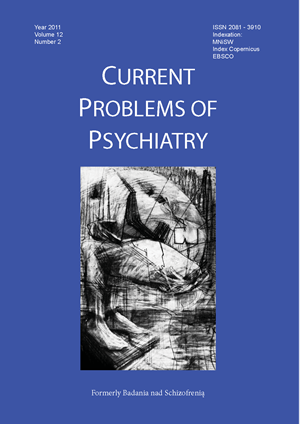Internet addiction of daughters of alcoholics and their relationships with alcoholic parents
Keywords:
Internet addiction, alcohol addiction, familyAbstract
The aim of this study was to find answers to the following research problems (issues) :
- Are there any differences in the symptoms of internet addiction among girls who are children of alcoholics and those who do not have alcoholic parents and what are they ?
- Are there any dependencies between the symptoms of internet addiction and family relationships in the families of daughters of alcoholic parents and what are they ?
Methods and the examined group: The investigation included a group of 216 girls, aged from 16 to 19 years, who were high school students. 23 of the examined students had alcoholic parents. In the research the following tools were used : a socio-demographic Questionnaire, Survey to Examine the Internet Abuse created by Emilia Potembska, Internet Addiction Test created by Young, Questionnaire for Internet Addiction Studies (KBIU) created by Beata Pawłowska and Emilia Potembska, and The Questionnaire for the study of disturbed relationships in the family created by Beata Pawłowska.
Results and conclusions: On the basis of the statistical analysis the following conclusions were drawn: 1. Daughters of alcoholics significantly more often treat the Internet and computer games as a way to forget about their reality and make themselves happy. 2. Mental and physical abuse of children who have alcoholic parents correlates with the children`s use of the web pornographic pages and playing violent computer games. 3. Children who lack acceptance, understanding and feel rejected by their families are of the opinion that only the Internet can give them a chance to express their true feelings, opinions , share their problems and gain acceptance and understanding.
References
1. Pallanti S., Bernardi S., Quercioli L. The Sorter PROMIS questionnaire and the Internet Addiction Scale in the assessment of multiple addictions in a high school population: prevalence and related disability. CNS Spectrums, 2006; 11: 966-974.
2. Chambers R.A., Taylor J.R., Potenza M.N. Developmental neurocircuitry of motivation in adolescence: a critical period of addiction vulnerability. Am J Psychiatry., 2003; 160: 1041-1052.
3. Han D.H., Lee, Y.S., Yang K.C., Kim, E.Y., Lyoo I.K., Renshaw P.F. Dopamine Genes and Reward Dependence in Adolescents with Excessive Internet Video Game Play. J. Add. Med., 2007;1(3): 133-138.
4. Yen J.Y., Yen C.F., Chen C.C., Chen S.H., Ko C.H. Family factors of internet addiction and substance use experience in Taiwanese adolescents. Cyberpsychol. Behav., 2007; 10(3): 323-329.
5. Yen C.F., Ko C.H., Yen J.Y., Chang Y.P., Cheng C.P. Multi-dimensional discriminative factors for Internet addiction among adolescents regarding gender and age. Psychiatry Clin. Neurosci., 2009; 63(3): 357-364.
6. Ko C.H., Yen J.Y., Yen C.F., Chen C.S., Weng C.C., Chen C.C. The association between Internet addiction and problematic alcohol use in adolescents: the problem behavior model. Cyberpsychol. Behav., 2008; 11(5): 571-576.
7. Yang C.K. Sociopsychiatric characteristics of adolescents who use computers to excess. Acta Psychiatr. Scand., 2001; 104: 217-222.
8. Tichon J.G., Shapiro M. The process of sharing social support in cyberspace. Cyberpsychol. Behav., 2003; 6: 161-170.
9. Wolak J., Mitchell K.J., Finkelhor D. Escaping or connecting? Characteristics of youth who form close online relationships. Journal of Adolescence, 2003; 26: 105-119.
10. Lam L.T., Peng Z.W., Mai J.C., Jing J. Factors associated with Internet addiction among adolescents. Cyberpsychol. Behav., 2009; 12: 551-555.
11. Park S.K., Kim J.Y., Cho C.B. Prevalence of Internet addiction and correlations with family factors among South Korean adolescents. Adolescence, 2008; 43(172): 895-909.
12. Pawłowska B., Potembska E. Korzystanie z pornografii internetowej przez uczennice szkół średnich w kontekście czynników rodzinnych. Roczniki Nauk o Rodzinie, 2010; (praca w druku).
13. Xiuqin H., Huimin Z., Mengchen L., Jinan W., Ying Z., Ran T. Mental health, personality, and parental rearing styles of adolescents with Internet addiction disorder. Cyberpsychol. Behav. Soc. Netw., 2010; 13(4): 401-406.
14. Kwon J.H., Chung C.S., Lee J. The effects of escape from self and interpersonal relationship on the pathological use of internet games. Community Ment Health J., 2011; 47(1): 113-121.
15. Pawłowska B., Potembska E. Właściwości psychometryczne Kwestionariusza do Badania Uzależnienia od Internetu (KBUI). Bad. Schizofr., 2009; 10: 310-321.
16. Young K.S. Internet addiction: The emergence of a new clinical disorder. Cyberpsychol. Behav., 1996; 1: 237-244.
17. Pawłowska B., Potembska E. Właściwości psychometryczne Kwestionariusza do Badania Zaburzonych Relacji w Rodzinie (KBZRR). Curr. Probl. Psychiatry, 2010; 11(2): 119-126.
Downloads
Published
Issue
Section
License
Copyright (c) 2011 Authors

This work is licensed under a Creative Commons Attribution-NonCommercial-NoDerivatives 3.0 Unported License.


